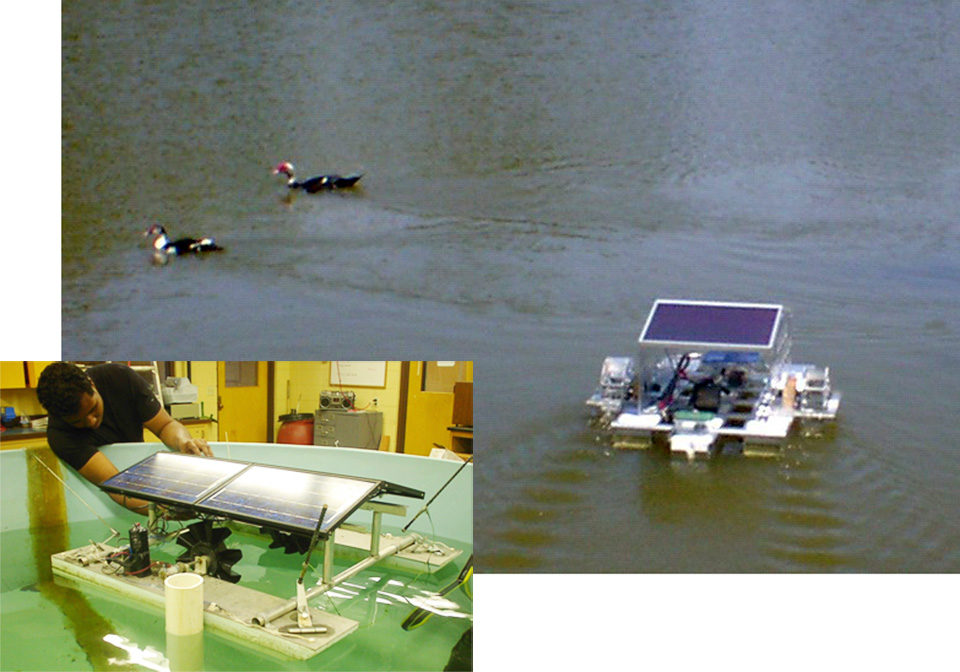Self-guided boats cruise ponds to scare away birds, monitor water quality

Attention to environmental issues in aquaculture has been growing in recent years, and with a continuing challenge to do so in an environmentally friendly way. Various aspects of aquaculture production can even reduce environmental impacts while improving yield.
To this effect, the authors recently explored the technology of autonomous vehicles at the Louisiana State University Agriculture Center in Baton Rouge, Louisiana, USA, to address bird predation issues and track water quality and other environmental parameters.
Robotic autonomy
Robotic autonomy implies the capability of the device to operate for extended periods, make decisions, and act without human direction. Small autonomous vehicles provide an environmentally friendly alternative approach to labor-intensive or destructive methods used to maintain production and water quality. Some robotic successes have included bird predation reduction devices, mobile environmental monitoring equipment, and remote photography systems.
Bird predation and control
Bird predation in aquaculture can decimate fish yields. Researchers have reported losses on catfish farms amounting to U.S. $3.3 million in Mississippi, USA, alone due to double-crested cormorants. Present approaches to control the birds include sonic cannons, poison, scarecrows, and nets. Each method has environmental, toxicity, or cost constraints.
Alternatively, small self-guided boats can patrol the pond, using passive and active methods to scare the birds away. They use small shore sensors that close a magnetic switch and guide the boat back into the pond, or global positioning, especially in open water. Low-power (< 0.1 ampere at 5 V) microprocessors provide guidance, while solar panels provide power. Infrared sensors can be used to identify birds and onboard water cannons can actively repel birds.
Efficacy tests
Efficacy tests were carried out in 0.4-ha catfish fingerling ponds located at the Louisiana State University Agriculture Center Aquaculture Research Station (ARS). Atimelapse video cassette recorder was used to record bird activity with a security camera.
Statistical analysis showed a significant reduction of cormorant, egret, and heron predation on ponds with boats. The diving cormorants were reduced from an average of 5.45 to 0.81 birds per hour, a 70 percent reduction. Wading birds went from 4.47 to 1.36 birds per hour. On an averaged daily basis, the reductions in predation by diving and wading birds were 64 percent and 55 percent, respectively.
Additional developments
Additional developments include motion-detection systems that use near-infrared sensors and machine vision, energy conservation improvements, more-effective navigation, and additional environmentally friendly bird-hazing mechanisms such as laser lights or sounds.
Other applications
Environmental applications include using the device to drive birds off recreational ponds, and swimming or drinking water reservoirs. Additionally, the boats can be fitted with water quality and environmental-monitoring equipment such as temperature, dissolved oxygen, nitrogen, pH, or other probes to measure water quality parameters and biological activity.
Semiautonomous vehicles that can be radio-controlled during part of their task and autonomous – with or without GPS guidance – during other parts of their work are being tested. Related developments of autonomous vehicles for land, water, and air applications in agriculture and the environment are also under way.
(Editor’s Note: This article was originally published in the August 2003 print edition of the Global Aquaculture Advocate.)
Now that you've finished reading the article ...
… we hope you’ll consider supporting our mission to document the evolution of the global aquaculture industry and share our vast network of contributors’ expansive knowledge every week.
By becoming a Global Seafood Alliance member, you’re ensuring that all of the pre-competitive work we do through member benefits, resources and events can continue. Individual membership costs just $50 a year. GSA individual and corporate members receive complimentary access to a series of GOAL virtual events beginning in April. Join now.
Not a GSA member? Join us.
Authors
-
Steven G. Hall, Ph.D., P.E.
Department of Biological and Agricultural Engineering
Louisiana State University Agriculture Center
Baton Rouge, Louisiana 70803 USA -
Randy R. Price, Ph.D.
Department of Biological and Agricultural Engineering
Louisiana State University Agriculture Center
Baton Rouge, Louisiana 70803 USA
Tagged With
Related Posts

Innovation & Investment
Eight digital technologies disrupting aquaculture
Eight digital technologies are disrupting aquaculture and having a profound impact on the way business operates – even displacing some established ones.

Innovation & Investment
Rise of the machines: Aquaculture’s robotic revolution
Technological advances are revolutionizing aquaculture. From airborne inspection tools to underwater drones, innovative robotics and automation technology are unveiling a brave new world of futuristic farming.

Innovation & Investment
Fish farmers turn to drones for health, feed monitoring
Two technology startups are offering unique fish-monitoring solutions for aquaculture producers. Using algorithms, drones and computer vision software, Aquaai and Aquabyte aim to take labor-intensive and error-prone tasks out of human hands.

Innovation & Investment
Exit stage right: Fish 2.0 offers final set of winning innovators
Nearly 40 entrepreneurs took the stage to pitch their seafood industry-changing innovations in front of a room full of discriminating investors.


